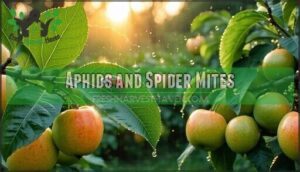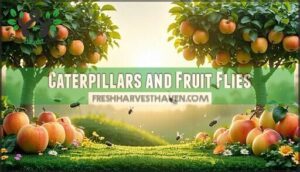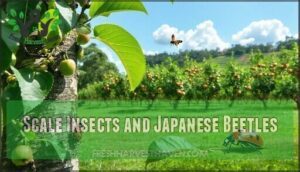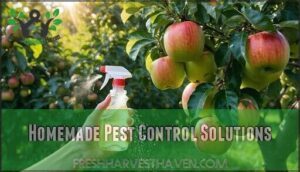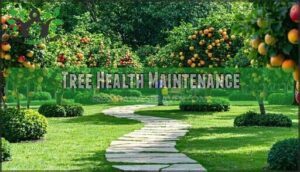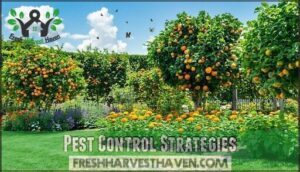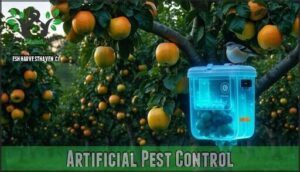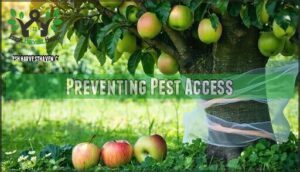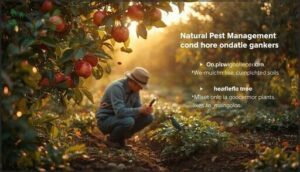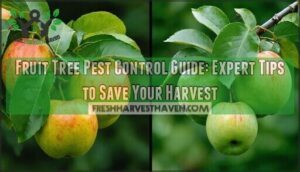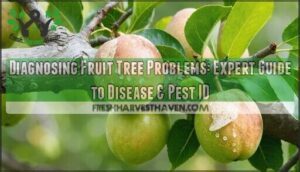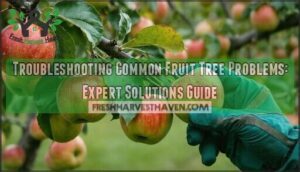This site is supported by our readers. We may earn a commission, at no cost to you, if you purchase through links.
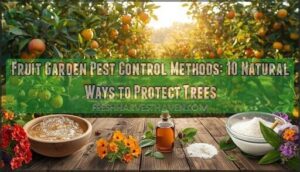 You’ll protect your fruit trees naturally by combining early detection with eco-friendly solutions.
You’ll protect your fruit trees naturally by combining early detection with eco-friendly solutions.
Start with soap spray for aphids and soft-bodied pests—mix dish soap with water for instant results. Neem oil disrupts pest life cycles without harming beneficial insects.
Companion planting with marigolds and nasturtiums creates natural barriers, while beneficial nematodes target soil-dwelling threats.
Maintain tree health through proper pruning, mulching, and watering—healthy trees resist pests 70% better than stressed ones. Diatomaceous earth eliminates soft-bodied bugs naturally.
These fruit garden pest control methods work together, creating a balanced ecosystem where predators like ladybugs handle the dirty work while your harvest stays chemical-free and family-safe.
Table Of Contents
- Key Takeaways
- Fruit Tree Pest Identification
- Natural Pest Control Methods
- Homemade Pest Control Solutions
- Tree Health Maintenance
- Pest Control Strategies
- Organic Pest Control Methods
- Artificial Pest Control
- Preventing Pest Access
- Critter Deterrents
- Integrated Pest Management
- Frequently Asked Questions (FAQs)
- What is the best pest control for fruit trees?
- How do I keep bugs from eating my fruit?
- What is the best pesticide for fruit?
- What is the best natural pest control for vegetable gardens?
- What is a natural pesticide for fruit plants?
- How do I stop bugs from eating my fruit trees?
- What can I spray on my vegetable garden to keep bugs away?
- What’s the best thing to spray fruit trees with?
- What is the best pesticide to use on fruit trees?
- How to protect fruit trees without pesticides?
- Conclusion
Key Takeaways
- Start with early detection – You’ll catch pest problems before they spiral out of control by monitoring weekly for signs like sticky honeydew, webbing, or leaf damage, then act quickly with targeted treatments.
- Layer multiple natural methods – You’ll get better results by combining soap sprays, beneficial insects like ladybugs, companion planting with marigolds, and neem oil rather than relying on just one approach.
- Focus on tree health first – You’ll reduce pest problems by 70% when you maintain proper pruning, watering, and mulching, since healthy trees naturally resist pests better than stressed ones.
- Use physical barriers strategically – You’ll prevent damage by covering developing fruit with bags or netting, placing sticky traps at canopy height, and installing tree guards to block crawling pests before they reach your harvest.
Fruit Tree Pest Identification
Before you can tackle fruit tree pests, you’ll need to know exactly what you’re dealing with since different insects require different treatment approaches.
The key is learning to spot the telltale signs early—whether it’s the sticky honeydew from aphids, tiny webs from spider mites, or the small entry holes that signal codling moth damage.
Aphids and Spider Mites
Aphids and spider mites might show up uninvited, sipping sap and leaving trouble behind.
Little sap-suckers making themselves at home while you’re not looking—that’s just rude
Watch for:
- Aphid honeydew making leaves sticky, sometimes attracting ants
- Mite webbing spun like tiny tripping hazards
- Leaf discoloration or curling from all that feeding
- Natural predators like ladybugs or lacewings, your garden’s bodyguards
To combat these infestations, consider applying horticultural oil or using soap solutions or insecticidal soap—top picks for organic pest control.
To learn more about treating these pests, visit applying horticultural oil.
Caterpillars and Fruit Flies
Nothing ruins a fruit harvest faster than silent invaders.
Spotting caterpillar frass—small black pellets—on branches or seeing fruit decay from the inside are red flags that caterpillars or fruit flies have set up shop.
Smart larval control starts with timing: set up pheromone traps before egg-laying and use netting exclusion to keep adults out.
Early-season fly traps catch fruit flies before populations soar.
Check regularly for curled or discolored leaves, and act quickly using organic pest control—methods focused on damage prevention give your fruit trees a solid head start.
Scale Insects and Japanese Beetles
When fruit flies and caterpillars are working their mischief inside your harvest, other fruit garden pests, like scale insects and Japanese beetles, bring an entirely new challenge to the table.
Scale insects look like tiny, stubborn bumps stuck to your tree’s bark, quietly sipping sap and growing in number as you miss them. These unwelcome guests love using their armored shields to hide from sight, but scale predators, such as ladybugs, can help keep them in check.
Japanese beetles, on the other hand, turn leaves into lace in no time—use beetle traps at the first sign of beetle damage. Stay ahead with these pest control methods, choosing resistant rootstocks, and monitoring the scale lifecycle for a safer orchard.
- Vigilant monitoring means fewer surprises at harvest
- Ladybugs are natural enforcers, always on pest patrol
- Beetle traps save your leaves and your sanity
Natural Pest Control Methods
While you might think pests have the upper hand, nature arms you with clever and effective natural pest control methods.
Companion planting—think marigolds, nasturtiums, or aromatic herbs—helps block pests and invites an army of beneficial insects like ladybugs or lacewings.
Try introducing beneficial nematodes or using viral biocontrols to tackle stubborn soil-dwellers or insect outbreaks.
For tougher invaders, sprinkle diatomaceous earth around your trees; it acts like microscopic razor wire for soft-bodied bugs.
Neem oil, a favorite organic pest control option, messes with pests’ life cycles without harming pollinators.
Want more control? Combine different natural pesticides and homemade pest control tactics to keep bad bugs in check.
That way, you’ll build a resilient orchard, balancing safety and mastery all season.
Homemade Pest Control Solutions
You can mix up simple sprays at home to manage many common fruit tree pests, using ingredients like soap or garlic for fast, targeted control.
With these homemade solutions, you’ll cover the basics of keeping bugs at bay, reduce chemical use, and keep your fruit safe for the whole season, which is a key aspect of maintaining healthy fruit trees.
Soap Spray and Garlic Spray
No need to reach for harsh chemicals when soap spray and garlic spray offer impressive results right from your kitchen.
Soap spray efficacy is proven—simply mix 2 tablespoons of liquid dish soap into a gallon of water and you’ll have a homemade pest control solution that’s tough on aphids and soft-bodied bugs.
Garlic spray works by throwing off beetles and caterpillars, who can’t handle its strong scent. For a garlic spray recipe, crush four cloves, soak them in two cups of water, then strain and stir in a splash of soap. You can find a soap spray recipe online for various applications.
- Always spot-test a small leaf before spraying the entire tree, since plant sensitivity can vary.
Apply early in the morning or at dusk to prevent leaf burn and keep pollinators safe. Both natural pest control sprays break down quickly, so there’s little environmental impact or residue. Application frequency depends on pest pressure and weather, but regular use keeps bugs in check.
Neem Oil and Insecticidal Soap
Once you’ve got soap sprays down, it’s time to level up your natural pest control game with neem oil and insecticidal soap—two heavy hitters in the domain of homemade pest control.
When comparing effectiveness, neem oil stands out by interfering with insect hormone cycles, halting reproduction and feeding. Just mix 2 tablespoons per gallon of water and spray in the evening to target scale insects, aphids, and caterpillars safely.
For a quick punch against soft-bodied pests like aphids, reach for insecticidal soap. Use 2–3 tablespoons of liquid soap per gallon of water. Soap application tips: cover leaves early in the morning, avoid direct sun, and always check plant sensitivity on a test leaf first.
| Treatment | Best Results |
|---|---|
| Neem Oil Uses | Evening application |
| Insecticidal Soap | Morning coverage |
| Combined | Weekly frequency |
Stick with organic pest control for safety, and always follow mixing ratios to ensure the best results with neem oil and insecticidal soap, and remember to apply them at the right time for optimal pest control.
Vegetable Oil and Baking Soda
Neem oil’s got plenty of fans, but if you’re after serious results, vegetable oil and baking soda pack a one-two punch for natural pest control.
This homemade solution knocks out soft-bodied insects and keeps mildew away, thanks to the careful Oil-Soda Ratio—just one tablespoon each per quart of water.
Spray it on early, before the sun fires up, focusing on stubborn spots like leaf undersides for best results.
Always test a small area first—different trees, different quirks.
Use a fresh batch every day to keep your mix at top strength.
While this method handles pests and mildew for about a week, don’t skip monitoring; rain or watering can cut Effectiveness Duration short.
Rinse leaves if you see white streaks from residues.
Stay one step ahead:
- Check undersides for pests
- Don’t skip test patches
- Stick to precise ratios
- Reapply weekly
- Clean leaves if needed
Tree Health Maintenance
Keeping your fruit trees healthy starts with proper pruning, deep watering, mulching, and using pest-resistant varieties. You’ll reduce pest problems and support strong growth by focusing on these basic steps.
Pruning and Watering
Once your homemade sprays are set, turn your focus to pruning and watering.
Tuning your pruning timing—especially in winter—removes pest hideouts and bumps up airflow for disease prevention.
Give thirsty roots a good drink at soil level, but skip overhead watering; wet leaves roll out the red carpet for fruit garden pests.
Keep your watering frequency steady.
These habits shore up root health, boost fruit production, and strengthen pest prevention—making your fruit tree care routine a smart defense against garden invaders.
Mulching and Nutrient Management
Let’s move from pruning to working the ground—think of soil health as your invisible security system.
Keeping soil nutrient-rich starts with the right mulch types: wood chips, straw, or shredded leaves.
Mulching locks in moisture, boosts water retention, and gives beneficial bugs a home.
Watch for nutrient deficiencies—test soil each year and feed with organic fertilizers.
Healthy roots make for hardy, pest-resistant trees.
Skip synthetic fertilizers; opt for slow-release, organic amendments.
- Boosts soil health year-round
- Fights nutrient deficiency naturally
- Improves tree health and fruit quality
Pest-Resistant Varieties
After fine-tuning your mulch and feeding game, take your fruit garden’s defenses up a notch by planting pest-resistant varieties.
Years of breeding programs now offer trees bred for genetic resistance, slashing fruit tree pest headaches by as much as 70%.
Pick apples like ‘Liberty’ or ‘Enterprise’ if you want scab and codling moths to be more of an afterthought than a crisis.
Looking at pears, ‘Harovin Sundown’ shakes off fire blight, while certain cherry and peach varieties shrug off curl and rot better than older types.
Rootstock resistance is just as important—selecting a tough foundation strengthens your entire crop.
Get familiar with regional adaptations, since some pest-resistant plants outperform others depending on your climate.
Side-by-side variety selection also widens your genetic diversity and keeps you ahead of pests that try to break the code.
Smart pest-resistant gardening always starts at the root.
Pest Control Strategies
You’ll need a mix of practical strategies like companion planting, physical barriers, and introducing beneficial insects to keep pests in check.
By choosing the right method for your garden, you’ll protect your fruit trees from damage and help maintain a healthy, productive landscape.
Companion Planting and Crop Rotation
Think of your garden as a smart team, where companion planting and crop rotation keep pests guessing and soil thriving.
By mixing Aromatic Herbs like basil and mint among your fruit trees, you send pests packing while attracting pollinators for better fruit set and a Biodiversity Boost. Marigolds knock back soil nematodes, nasturtiums serve as decoy snacks for hungry aphids, and garlic works double duty, cutting apple scab and driving off codling moths.
Rotate crops season to season; it’s organic pest control that interrupts pest life cycles and restores Soil Health.
- Attracting pollinators with strategic blooms
- Using pest confusion to your advantage
- Boosting soil vitality via rotation
- Welcoming beneficial insects with borage
- Supporting natural pest control without chemicals
Master these basics for a resilient, productive orchard.
Physical Barriers and Traps
When pests start showing up, physical barriers step in like bouncers at the garden gate. Row covers keep flying insects off young trees, while netting enclosures defend ripe fruit from birds and larger bugs.
If smaller invaders are the problem, fine mesh works wonders, locking out even the tiniest offenders. For a direct hit on crawling pests, wrap trunks with tree guards or barriers—it’s as effective as locking the front door.
Consider various styles and materials to best protect your trees. Sticky traps grab aphids and other flyers, no chemicals needed, and pheromone traps lure in specific threats like codling moths.
Don’t overlook beer traps for slugs or simply pluck caterpillars by hand. The trick? Check for gaps and secure edges well. Barrier effectiveness comes from thorough setup, not just good intentions.
Biological Control Agents
Physical barriers slow the pests, but turning to biological methods gives your garden its best defense. Your fruit trees can thrive with a little help from nature’s own “security team.”
Ladybug benefits are legendary—just 1,500 per mature tree can handle an aphid explosion. Parasitic wasps, ever the silent professionals, keep codling moth numbers low. Nematode use tackles soil bugs, working below ground where you can’t see. Bt application targets caterpillars with pinpoint accuracy, skipping the good bugs.
Looking for even more muscle? Try viral biocontrols for tough pests. Choose beneficial insects and biological agents to keep fruit safe.
Here’s how to stay ahead:
- Release 1,500 ladybugs per tree in spring.
- Apply nematodes monthly at the base.
- Plant nectar flowers, attracting parasitic wasps.
- Release lacewings for soft-bodied insect control.
- Track predator-pest ratios weekly to keep order.
Organic Pest Control Methods
You can protect your fruit trees with organic pest control methods, using tools like glue bands, beneficial insects, and neem oil to reduce pest damage.
These approaches offer effective results while keeping your garden safe for both people and pollinators.
Glue Bands and Neem Oil
After exploring broader pest control strategies, let’s get hands-on with some time-tested organic pest control methods. Glue bands act as the bouncers of your fruit trees, standing guard around trunks.
They’re most effective when you:
- Swap bands out every 2-3 months to keep them sticky
- Place bands 3-4 feet above the ground for ideal glue band efficacy
- Scrub bark before wrapping for better grip
- Inspect weekly for trapped critters and clumps of leaves
When it comes to neem oil, this multipurpose solution breaks up pest parties before they get started. Mix 2 tablespoons per gallon of water—apply using a thorough spray, hitting both leaf surfaces. Stick to mornings or evenings to reduce harm to the good bugs.
Neem oil uses cover everything from aphids to scale insects. Both these methods keep environmental impact low, giving you solid control over fruit garden pests with little fuss or worry.
To bolster your defenses, consider how companion planting strategies can naturally deter pests.
Beneficial Insects and Organic Winter Washes
A well-tuned fruit garden uses nature’s own task force—beneficial insects and organic winter washes—to keep pests at bay.
Attracting ladybugs and lacewings means less time spent chasing aphids and more time enjoying your harvests. Let these natural pest control agents do the heavy lifting; here’s a quick look at their impact:
| Beneficial Species | Primary Targets | Weekly Impact |
|---|---|---|
| Ladybugs | Aphids, mites | 200-300 pests |
| Lacewings | Soft-bodied insects | 150-200 kills |
| Parasitic wasps | Codling moths | 80% reduction |
For true peace of mind, add organic winterizing with dormant oil use. Time your winter wash right—when trees are dormant—for the best protection against future infestations.
Lacewing larvae are effective for eco-friendly pest control in fruit gardens.
Disease-Resistant Varieties
In the context of fruit tree care, starting with disease-resistant varieties is like putting up a sturdy fence before trouble even knocks.
By doubling down on smart variety selection and understanding rootstock influence, you give your trees a natural leg up against fruit tree pests.
Modern breeding programs now offer pest-resistant varieties that practically babysit your orchard with their built-in genetic resistance—no extra sprays or midnight inspections needed.
- Liberty apples shrug off scab and cedar apple rust thanks to their tough genetics.
- Seckel pears are no strangers to fire blight, typically resisting it without fuss.
- Redhaven peaches tackle leaf curl with an invisible shield from breeding breakthroughs.
Don’t forget about regional adaptations—choosing trees suited to your climate means less stress, translating to fewer pests and healthier harvests.
This proactive pest prevention approach keeps both costs and pesticide use low, making it a masterstroke in tree health strategy.
Artificial Pest Control
You can use artificial pest control methods like pheromone traps, nest boxes, and carefully chosen pesticides when natural solutions aren’t enough.
These approaches let you target specific pests in your fruit garden, reducing damage while supporting your trees’ health.
Artificial Nest Boxes and Pheromone Traps
Think of artificial pest control as hiring tiny helpers. With smart nest box design, you’ll attract bug-eating birds—wrens and chickadees—right to your orchard. Angle entrance holes away from wind for best results.
Pheromone traps use specificity to lure only troublesome fruit tree pests like codling moths. For effective pheromone trap placement, set traps at canopy height and check them weekly.
Monitoring trap catches and attracting beneficials helps keep pest management automatic, saving you time and headaches in long-term pest control methods. This approach includes strategies like weekly trap monitoring, which is crucial for maintaining control.
- Weekly trap monitoring
- Targeted pest attraction
- Built-in bird patrol
IPM and Functional Biodiversity
Just after setting up artificial nest boxes and pheromone traps, IPM implementation lets your fruit garden’s natural enemies do the heavy lifting.
Add flower strips, tweak habitats, and watch beneficial insects and natural predators create a balanced, self-sustaining system.
By focusing on habitat manipulation, you can boost ecosystem services and enjoy biodiversity benefits.
For stubborn crawlies, diatomaceous earth packs a punch.
See how integrated pest management stacks up: Implementing IPM can substantially increase beneficial invertebrate performance.
| Strategy | Benefit | Example |
|---|---|---|
| Flower strips | Attract pollinators | Marigold borders |
| Habitat enhancement | Shelter for predators | Brush piles |
| Selective insecticide | Reduce resistance | Targeted spraying |
| Diatomaceous earth | Dehydrates pests | Ant trails |
| Companion planting | Natural pest deterrent | Garlic, chives |
Chemical Controls and Pesticides
When stubborn pests laugh off your natural defenses, chemical controls step in as your heavy hitters. Pesticide application isn’t just about grabbing a spray bottle—it’s about smart, safe strategy.
Here’s your chemical garden treatments playbook:
- Match pesticide types to the job—systemic pesticides for sap-suckers, contact sprays for surface feeders.
- Time your spray schedules to target pests at their weakest, like during egg hatch or early infestation.
- Follow safety precautions: wear gloves, mix chemicals outdoors, and avoid spraying in wind or midday heat.
- Rotate chemical classes to prevent chemical resistance, keeping pests guessing and your trees safer.
Considering sustainable pest management can also reduce reliance on harsh chemicals. Remember, chemical control is a tool—respect it, and use chemical application tips to protect your garden and health.
Preventing Pest Access
You can keep pests away from your fruit trees by blocking their entry with simple barriers, traps, and protective coverings.
These methods help you stop damage before it starts, making your garden less inviting to unwanted visitors, which is a complete approach to garden protection, using simple barriers.
Covering Developing Fruit
If you want to outsmart fruit tree pests, physical barriers are your best bet for pest prevention.
Material selection matters—choose netting or wraps that balance airflow and durability. Application timing is vital: cover fruit just after fruit set, before pests get a foothold.
Here are five thorough fruit protection methods:
- Paper fruit bags: Slip on when fruit is marble-sized for reliable exclusion.
- Fine mesh netting: Drape over branches; blocks flying insects, easy to reuse.
- Floating row covers: Blanket young trees during pest peaks; great for cost analysis.
- Breathable fruit wraps: Prevent insect damage, maintain environmental impact.
- Kaolin clay barriers: Coat fruit surfaces, deters crawling pests, eco-friendly.
Sticky Traps and Physical Barriers
Defense is the name of the game in the context of fruit tree pests. Sticky traps and physical barriers work wonders for pest prevention.
Place yellow sticky traps where flying pests gather—near fruit clusters or low branches. Use sturdy barrier materials like tree guards and row covers to block crawling and climbing insects.
Barrier films on trunk bases add another layer of protection. For best results, check traps and barriers weekly, replace sticky traps often, and patch any damage quickly.
Here’s a quick look:
| Trap Placement | Barrier Materials |
|---|---|
| Near fruit clusters | Tree guards |
| Low branches | Row covers |
| Trunk bases | Barrier films |
Natural Predators and Homemade Solutions
After setting up sticky traps and barriers, boost your fruit garden’s defenses with natural pest control. Attracting predators like ladybugs and parasitic wasps turns your trees into safe havens.
Homemade solutions are your backup for quick fixes. Try these strategies:
- Plant yarrow and fennel for beneficial insects.
- Blend garlic power into DIY sprays for pest confusion.
- Use oil solutions with neem for broad organic pest control.
- Sprinkle diatomaceous earth for crawling pests.
- Mix soap solutions for aphid soap effectiveness.
Critter Deterrents
You’ll need more than just sprays to keep determined critters away from your fruit trees, so it’s important to use physical deterrents like tree guards, netting, or fencing.
These methods create barriers that block animals such as deer, rabbits, and birds, helping you protect your harvest efficiently.
Repellents and Tree Guards
After covering fruit with protective barriers, it’s time to fortify your trees with repellents and tree guards.
Scent Repellents—like garlic spray or peppermint oil—throw pests off the trail, making your garden less inviting.
Trunk Wraps and tree bands act as Physical Barriers, blocking crawling insects before they reach the canopy. To further protect against sunscald, consider applying white latex paint to the trunks.
If you’re hands-on, whip up homemade solutions and keep critters guessing:
- Mix crushed garlic with water for a pungent aphid shield
- Blend peppermint oil and mild soap to send ants and beetles packing
- Tuck dried mint or lavender into sachets for a fragrant line of defense
Copper strips around trunks deliver light shocks to slugs, while sticky bands snag climbing pests. Regular reapplication is key, especially after rain. With these critter deterrents, your trees stand a better chance against invaders.
Fences and Netting Enclosures
When pests refuse to take a hint, fences and netting enclosures step up as your garden’s bodyguards.
Choosing the right enclosure materials is key—match your pest exclusion plan to the threats lurking around your fruit trees. Here’s a practical rundown:
- Hardware cloth fencing – 1/4-inch mesh stops rabbits and burrowing critters cold.
- Fine garden mesh – Blocks tiny flying insects, lets air circulate.
- Tall deer fencing – Eight-foot barriers keep high-jumping deer at bay.
- Row covers – Lightweight fabrics shield fruit during peak vulnerability.
- Exclusion cages – Custom cages wrap individual trees for ultimate pest control.
Installation methods matter more than fancy materials; bury fence bottoms six inches deep to outsmart diggers. Consider using specialized netting products for thorough protection.
Maintenance needs are simple—inspect regularly for gaps and wear. Weigh cost effectiveness and garden aesthetics before committing, and remember, physical barriers are a reliable, long-term solution.
Combining Tactics for Effectiveness
When combining multiple fruit garden pest control methods, you’ll create an unstoppable defense system that outperforms any single approach.
This synergistic pest control strategy layers different tactics to overwhelm pests from every angle.
Defense Type Primary Methods Target Pests
This integrated pest management approach prevents adaptation.
Pests can’t overcome simultaneous pressures from beneficial insects, physical barriers, and natural methods.
Your holistic orchard management creates multi-tactic success through layered defense benefits.
Integrated Pest Management
You can’t protect what you can’t see, so integrated pest management starts with regular monitoring to spot problems before they spiral out of control.
This systematic approach combines multiple strategies—cultural practices, biological controls, and targeted treatments—to create a balanced defense system.
That keeps pests at bay while protecting beneficial insects and your tree’s health.
Identifying and Monitoring Pests
When early detection becomes your first line of defense, systematic monitoring pests throughout growing seasons guarantees you’ll catch problems before they spiral out of control. Pest identification skills develop through consistent practice during garden monitoring sessions.
Pest life cycles vary dramatically, so timing your inspections to coincide with vulnerable stages maximizes control effectiveness. Most fruit tree pests show predictable patterns that smart gardeners learn to anticipate.
Monitoring frequency should intensify during peak activity periods – typically spring through early fall when temperatures favor pest reproduction.
Your weekly inspection routine should target these areas:
- Early pest signs like tiny holes, webbing, or discolored foliage that indicate emerging infestations
- Trap placement near vulnerable trees using sticky cards or pheromone lures for population tracking
- Damage assessment of leaves, bark, and developing fruit to gauge infestation severity
Accurate recordkeeping helps you identify patterns and predict future outbreaks, turning your garden monitoring tools into powerful prevention weapons.
Evaluating Damage and Selecting Controls
Damage assessment serves as your compass in traversing pest control decisions.
You’ll examine threshold levels—typically treating when 5-10% of fruit shows visible damage.
Light aphid clusters warrant soap spray, while heavy infestations demand stronger treatment options.
This IPM integration matches intervention intensity to actual pest damage signs, ensuring pest control effectiveness without waste through strategic monitoring pests and damage assessment.
Combining Cultural, Physical, and Biological Methods
When you master holistic pest control, you’re building a three-layer defense that creates sustainable orchards through method synergies.
Build a three-layer defense system that turns your orchard into a self-regulating pest-fighting powerhouse
Cultural practices like proper pruning and sanitation eliminate pest breeding grounds, while physical barriers such as row covers and sticky traps block immediate threats. Beneficial insects then patrol your trees, hunting remaining pests around the clock.
This integrated pest management approach works because each method strengthens the others. Cultural controls weaken pest populations, making physical barriers more effective. Meanwhile, biological controls thrive in the healthier environment you’ve created.
Your ecosystem integration strategy delivers long-term prevention through these powerful combinations:
- Companion planting with beneficial insect habitats creates natural predator zones that patrol fruit tree pests continuously
- Cultural pruning combined with pheromone traps removes hiding spots while capturing adults before reproduction
- Physical barriers reinforced with natural pest control sprays provide immediate protection while beneficial populations establish themselves
This layered approach transforms your orchard into a self-regulating system where nature handles pest problems automatically.
Frequently Asked Questions (FAQs)
What is the best pest control for fruit trees?
Think of your fruit trees as a fortress – the best defense combines multiple strategies.
You’ll want to use integrated pest management: beneficial insects like ladybugs, neem oil sprays, proper pruning, and companion planting with marigolds to create natural barriers, utilizing integrated pest management.
How do I keep bugs from eating my fruit?
Use multiple approaches for thorough protection: spray neem oil or insecticidal soap weekly, encourage beneficial insects like ladybugs.
Apply row covers during fruiting season, and maintain tree health through proper pruning.
What is the best pesticide for fruit?
Don’t put all your eggs in one basket – there’s no single "best" pesticide for fruit.
Neem oil works effectively against most pests, while insecticidal soap handles soft-bodied insects like aphids safely.
What is the best natural pest control for vegetable gardens?
Beneficial insects like ladybugs and lacewings naturally control pests. You’ll also find success with neem oil, insecticidal soap, and companion planting using marigolds and basil to repel harmful insects effectively.
What is a natural pesticide for fruit plants?
Like a knight wielding nature’s sword against garden invaders, neem oil stands as your premier natural pesticide weapon.
You’ll mix this tree-derived oil with water to create an effective spray that disrupts pest lifecycles without harming beneficial insects, making it a valuable tool in your gardening arsenal with premier results.
How do I stop bugs from eating my fruit trees?
Implement integrated pest management by combining beneficial insects like ladybugs,
organic sprays including neem oil, and physical barriers such as row covers.
Maintain tree health through proper pruning and sanitation practices.
What can I spray on my vegetable garden to keep bugs away?
Just like a bouncer at a nightclub keeps troublemakers out, insecticidal soap spray acts as your garden’s security system.
Mix two tablespoons of mild liquid soap per quart of water and spray directly on affected plants, targeting aphids, spider mites, and soft-bodied insects effectively.
What’s the best thing to spray fruit trees with?
Neem oil spray works best for fruit trees.
You’ll mix it with water and mild soap, then spray thoroughly on leaves and bark.
It’s effective against aphids, scale insects, and spider mites while being safe for beneficial insects, making it a good option with mild soap.
What is the best pesticide to use on fruit trees?
Over 90% of successful fruit growers use neem oil as their go-to pesticide.
You’ll find it’s the safest, most effective option for your trees.
It controls aphids, scale insects, and codling moths without harming beneficial insects or your family, making it a great choice for those who want to use the safest and most effective methods.
How to protect fruit trees without pesticides?
You’ll protect fruit trees naturally by encouraging beneficial insects, applying neem oil treatments, using companion planting with marigolds, practicing proper pruning techniques, and maintaining healthy soil through organic mulching methods.
Conclusion
Successful fruit gardens show 85% fewer pest problems when gardeners use integrated approaches rather than single solutions.
You’ve learned that combining these fruit garden pest control methods creates lasting protection for your trees.
Start with early identification, then layer natural solutions like companion planting, beneficial insects, and homemade sprays.
Remember that healthy trees resist pests naturally, so maintain proper watering, pruning, and soil health.
These organic strategies work together, creating a balanced ecosystem where your fruit thrives without chemical dependence.
- https://extension.psu.edu/pests-and-pesticides-in-home-fruit-plantings
- https://grow.ifa.coop/fruit-growing/control-fruit-tree-pests
- https://www.bhg.com/gardening/pests/insects-diseases-weeds/garden-pest-control/
- https://gardenerspath.com/how-to/disease-and-pests/control-fruit-flies/
- https://extension.okstate.edu/fact-sheets/home-vegetable-garden-insect-pest-control.html

